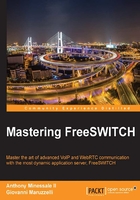
What this book covers
Chapter 1, Typical Voice Uses for FreeSWITCH, gives an overview and analyzes each sector where FreeSWITCH is in production.
Chapter 2, Deploying FreeSWITCH, shows best practices in FreeSWITCH installation and management.
Chapter 3, ITSP and Voice Codecs Optimization, suggests what to look for when choosing an Internet Telephony Service Provider, and how to get the best from DIDs, terminations, T38, and voice traffic.
Chapter 4, VoIP Security, exposes specific measures and tools used to keep FreeSWITCH protected from unwanted attention and hostile behavior.
Chapter 5, Audio File and Streaming Formats, Music on Hold, Recording Calls, covers all that is related to audio manipulation with FreeSWITCH, from prompts optimization to call center barge in, from playing live streams to HD codecs.
Chapter 6, PSTN and TDM, happens to be the first published, thorough explanation of all possible interactions between FreeSWITCH and Sangoma, Digium, and other compatible hardware for interfacing traditional and legacy telephony networks.
Chapter 7, WebRTC and Mod_Verto, provides a detailed overview of what WebRTC is and what techniques it entails, and then follows the development of a complete FreeSWITCH implementation.
Chapter 8, Audio and Video Conferencing, delves into the intricacies of setting and managing FreeSWITCH multiuser conferences both via SIP and WebRTC, with chatting, screen sharing, moderation, and advanced techniques for videocomposing the screen.
Chapter 9, Faxing and T38, explores all facsimile transmission aspects, and how to reliably fax via VoIP, send office documents, and integrate with mail.
Chapter 10, Advanced IVR with Lua, proves that it is not your average code snippet or more of the same example. Starting from the thoroughly described script techniques, it will be possible to build your industry-grade applications.
Chapter 11, Write Your FreeSWITCH Module in C, describes exactly what is needed to add or modify FreeSWITCH functionalities at the most fundamental level: interfacing your custom hardware, or your legacy OSS, or whatever.
Chapter 12, Tracing and Debugging VoIP, shows the art of SIP packet tracing, using the latest open source tools.
Chapter 13, Homer, Monitoring and Troubleshooting Your Communication Platform, walks through the operation of the most advanced VoIP/WebRTC monitoring and data warehousing solution: Homer. Once implemented, your support staff will reach Nirvana!